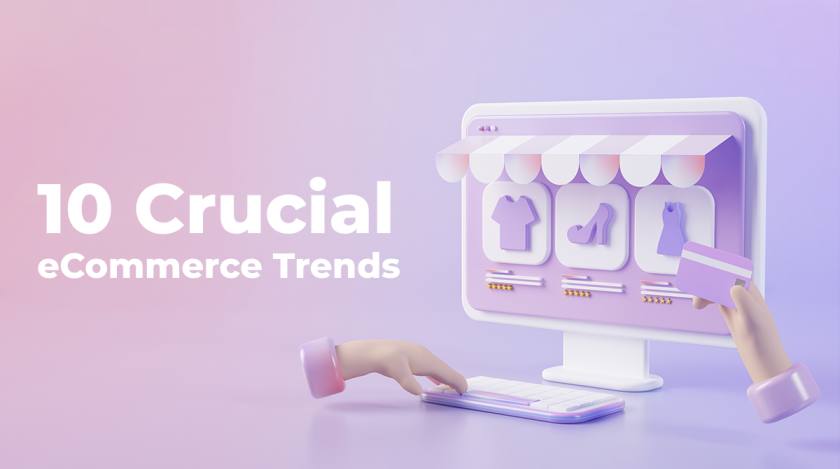In the ever-evolving world of eCommerce, staying ahead of the curve is crucial for success. Consumer behavior and expectations are constantly changing. Businesses need to keep up with the latest trends to stay relevant and competitive. In this article, we will explore 10 eCommerce trends that are currently shaping the industry. From the rise of social commerce to the importance of personalized experiences, these trends have the potential to greatly impact the way we shop online. So, whether you are an established eCommerce business or just starting out, read on to discover the latest trends and stay ahead of the game.
The world of eCommerce is in a constant state of flux. What worked last year might not work this year for eCommerce marketers, as audience tastes change and new technologies emerge.
It’s impossible to ballpark the number of existing eCommerce stores, with estimates suggesting there are between 12 – 24 million stores. Whatever the number, competition is fierce. To survive and thrive, you must stay on top of the latest eCommerce trends.
So what trends must you ignore at your cost? Let’s take a look at the top 10 eCommerce trends.
Voice search is increasing
Voice search allows your customers to search for products in your store faster than ever before.
They can shop on the move whenever they want, wherever they are. In a survey conducted in 2022 by UpCity, half of the U.S. population used voice search daily. Because people speak in more complex phrases, optimizing your website for longer phrases is vital to voice search for eCommerce.
It’s useful to understand how your customers talk. Imagine yourself searching for an item by voice, and think about what you would say. What would your phrases be?
Voice search keywords are also more local based – such as “men’s shoes Manhattan” – and they’re more conversational. For example, “Where can I find leather handbags for women?”
To help, you can use free tools like Google Keyword Planner or Answer the Public.
More stores will leverage AI
Artificial Intelligence is no longer something eCommerce store owners can avoid simply because it sounds “too intimidating.”
AI can drive eCommerce success by predicting purchase patterns and assisting store owners in multiple ways.
And the good news is, it’s nowhere near as complex as it sounds.
AI for eCommerce includes a list that’s increasing all the time. It incorporates things such as chatbots and product recommendations, customer retargeting, better lead qualification, channel personalization, and price optimization.
- Chatbots – Chatbots use Natural Language Processing to engage your customers 24/7, answer their queries and point them in the right direction.
- Product recommendations – AI-driven product recommendations use data (such as customer behavior and past purchases) to recommend product ideas that each customer might be interested in.
- Pricing optimization – AI can help you accurately price up your products so that they’re competitively priced, in line with what the market sees as fair, and which takes into consideration distribution and production costs.
- Conversational marketing – This form of marketing puts dialogue first in your 1:1 interactions with your customers across different channels. AI-driven tools like Emotive exist to help you engage your customers via SMS, text messages, and ads while helping you monitor your engagement analytics.
More stores will leverage augmented reality, too
Augmented Reality – which essentially allows your customers to shop with you in 3D while online – is on the rise, with 71% of customers claiming they would shop more frequently with a brand that uses AR.
Augmented Reality improves the shopping experience for the customer by giving them the chance to “try” before they buy. It creates a more meaningful shopping experience than video and can go a long way to reducing return rates.
AR technology is being utilized in eCommerce by companies such as MOSCOT. Customers can virtually try on glasses, while IKEA lets customers visualize their furniture interiors using 3D models.
Green is the new normal
Customers are now more switched on than ever before. They understand issues like sustainability – and they want to shop at online stores that are doing their bit when it comes to the environment.
According to McKinsey, 1 in 4 customers now say they want brands to have a social conscience.
This means that eCommerce stores can no longer see “sustainability” as a buzzword but must instead put issues such as the environment at the forefront of their overall marketing campaigns.
This might include:
- Donating a portion of profits to a good cause
- Partnering up with a charity
- Using sustainable packaging materials and sourcing methods
Whatever you do, make sure you communicate your sustainable projects via FAQs and social media.
Marketing automation
Marketing automation makes our lives easier, allowing eCommerce marketers to reach more customers in less time – and with less effort.
Essentially, marketing automation is the use of tools to take care of what are precisely manual, time-consuming tasks with more efficiency and greater accuracy.
Types of tools you can use for marketing automation include:
- Email marketing tools – Software like MailChimp lets you automate your email marketing campaigns for triggered emails, automated follow-up emails, and 24/7 support.
- Social media marketing tools – You can use a tool like HubSpot to get a better grip on your social media marketing strategy so that tasks like scheduling posts and republishing articles are done faster.
- CRM tools – A CRM tool, such as Drip, can integrate with your other marketing automation tools so that you get to optimize your funnel from top to bottom for more accurate results.
Cross-selling
Cross-selling is when you suggest related items to customers at the checkout, or on other pages on your website. It’s a great way of catching them when they’re in a buying mood, therefore adding a little extra to your overall profits.
For instance, you can take Amazon’s lead and add a “Frequently bought together” section to your checkout page, or a “You may also like” section.
Customer retention
Earlier, we noted how there could be as many as 24 million online stores in existence. This means that competition is stronger than ever – which also means that focusing on retaining customers should be a huge priority.
Research has shown that it’s much cheaper to retain existing customers than it is to find new ones.
Retaining customers is all about nurturing a strong relationship with them so that they become loyal to you. Here are some ways to do that:
- Create a loyalty program that rewards your customers each time they make a purchase.
- Improve the user experience so that it’s easy for customers to navigate your website, make purchases, and essentially complete their tasks with ease.
- Launch an email marketing campaign that helps you build lasting connections with your customers, keeping them in the loop with your latest offers and discounts.
Omnichannel shopping is king
92% of website visitors have no intention of making a purchase. What’s more, there are often as many as 8 touch points before a customer goes ahead and buys from a brand for the first time.
Indeed, customers have options – and they also need different ways to learn more about you and weigh up whether you’re the right brand for them.
What’s more, different customers have different tastes, needs, and wants. For instance, mobile users are more likely to purchase using a mobile app that has customized info according to their location. So, if you have a sufficient budget, opting for a mobile solution is a necessity. You can find Kotlin programmers to develop an Android app, Swift coders for iOS, and React Native developers for hire if you want a cross-platform solution.
Others are more likely to do business with you via social media, such as Facebook Pay, while others might prefer to interact with you via email.
Your channels and your customer data need to be connected to create a seamless omnichannel shopping experience. Thus, your customers can drift between all your channels without having to continually re-enter their information.
More payment methods
Cart abandonment rates average 70% – and if customers don’t see their preferred payment method at the checkout, there is every chance they won’t go through with the purchase.
Modern-day eCommerce stores should add as many trustworthy payment methods as possible.
That said, exactly which payment methods you add will depend on your customers’ needs and wants.
In order to obtain such information, conducting customer surveys and researching popular payment methods within your country can be useful.
However, if you’re managing an active subscriber base, then how you manage your billing is important too. If the thought of losing a single sale sends shivers down your spine, losing a subscriber should be enough to send you into a full-blown panic!
To avoid this, you need to ensure that your subscription management is top-notch. This means having the right systems and processes in place to ensure that your subscribers are billed accurately and on time.
Of course, many popular billing platforms, such as Stripe, have subscription management bolt-ons.
If you want a robust and fully-customizable solution, a Stripe competitor such as Chargebee may be a more suitable option. A purpose-built subscription management platform will provide you with a range of advanced features such as real-time reporting, extensive integrations, and advanced billing logic.
Optimized supply chain management
Supply chain management ensures the smooth flow of goods, from receiving them at your warehouse to packing them and shipping them.
It also confirms stock availability to your customers and prevents overstock and understock, both of which can have huge negative impacts on the customer experience (and your subsequent success with eCommerce fulfillment).
Here are some ways to improve your supply chain management for eCommerce:
- Automate tasks – You can implement (among other things) automated shipping to improve performance on the warehouse floor.
- Work With a 3PL – A 3PL can take a huge load off by taking care of order fulfillment for you so that time-consuming tasks such as returns processing are no longer your main concern.
- Use tools – By investing in tools like inventory management software or multichannel selling software, you can prevent over and under-stocks, plan and forecast inventory with greater accuracy, and essentially make your processes more efficient.
Top eCommerce Trends Conclusion
These are the top 10 eCommerce trends that store owners can’t ignore. Despite the fact that AI and AR are expected to be fundamental components of future eCommerce trends are fleeting.
In addition to incorporating the aforementioned ideas, it’s wise to keep up with the upcoming wave of eCommerce trends. Being one step ahead of the curve is the name of the game!
In addition, the eCommerce of the future is being influenced by millennials and Gen Z. To provide a shopping experience that caters to their preferences and behaviors, keeping up with them is crucial.















